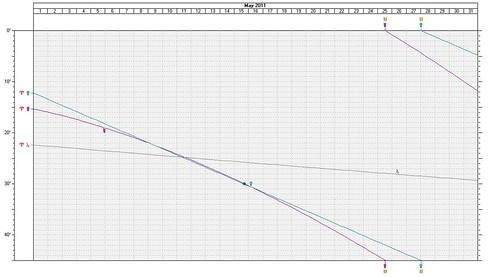There's about a two week period in May where the planets Mercury and Venus are traveling side by side in close conjunction, which doesn't normally happen. The graph below gives an idea of this. Notice the two lines that run together from the left down the the lower right. At one point they cross a third line, which represents their conjunction to Jupiter. Let's see what weather these conjunctions might engender. I'll try and mention the most outstanding dates and places.
There is an indication that the tropics will begin to awaken at this time. It doesn't necessarily mean that a tropical system will result but there's a strong possibility that a low pressure system will develop now about 420 northeast of the Lesser Antilles.
Another area that stands out for severe weather is the Texas and Oklahoma panhandles. Mercury and Venus together indicate increasing temperatures due to a moist, southerly airflow. This can indicate the ingredients necessary to trigger damaging thunderstorms, hail, and tornadoes. These storms could then continue in eastward transit toward the Mississippi Valley.
May 10-12, 2011
May 10-12, 2011
At this time the three planets, Mercury, Venus, and Jupiter all conjoin. A broad area in the west central Atlantic to the Lesser Antilles is activated now so we may continue to see low pressure areas that may be monitored for development.
The Plains continues to be an area of concern as more warm, moist air will be available as a mechanism for thunderstorm generation. Storm potential is therefore greatly enhanced now.
The Plains continues to be an area of concern as more warm, moist air will be available as a mechanism for thunderstorm generation. Storm potential is therefore greatly enhanced now.
The Full Moon and New Moon charts place these aspects over the West Coast States of California, Washington, and Oregon. Increasing heat and moisture could very well manifest as an increased monsoonal flow triggering storms over the area.
May 14-17, 2011
The West Coast States are still responding to increases in temperatures or at least warm, moist air masses. The area in and around Idaho is emphasized where storm development is a likely response.
Generally, the Plains through the Deep South and East Central States are experiencing an influx of warm, moist air from the Gulf which continues to provide the ingredients for storms.


2 comments:
Your projection of a low forming off the west coast of Calif in the April 18 to 20 was partially correct. We had weak impulses come thru that week with some rain in the foothills and 2 = 4 inches of snow from each impulse..the central valley received trace amounts each impulse..there were 3
Thanks, Bob for pointing that out. I wasn't sure what happened.
Ken
Post a Comment